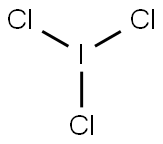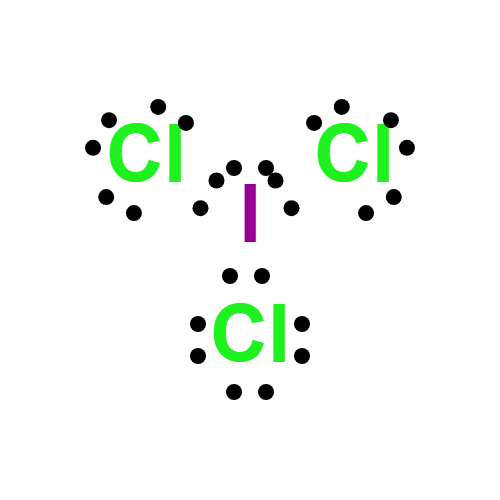Uses
Iodine trichloride is used in organic synthesis as a chlorinating and iodinating agent to introduce chlorine and iodine into organic compounds producing their halogen derivatives. It also is used as a topical antiseptic.
Preparation
Iodine trichloride is prepared by adding iodine to liquid chlorine in a stoichiometric amount:
3Cl2 + I2 → 2ICl3
Reactions
Iodine trichloride decomposes on heating at 77°C, forming iodine monochloride and chlorine:
ICl3 →ICl + Cl2
It dissolves in concentrated hydrochloric acid , forming HICl4•4H2O:
ICl3 + HCl + 4H2O → HICl4•4H2O
Iodine trichloride hydrolyzes in water or dilute acids, the products depending upon reaction conditions. This reaction usually is similar to iodine monochloride:
4ICl3 + 6H2O → I2 + 6HCl + 2HIO3 + 3Cl2
It combines with potassium chloride, forming a complex salt, KICl4:
ICl3 + KCl → KICl4
Reaction with acetylene produces chlorovinyl iododichloride, containing two active chlorine atoms attached to the iodine atom:
ICl3 + HC≡CH → ClCH=CHICl2
The above product has many applications in chemical synthesis.
Toxicity
Iodine trichloride is highly corrosive. Contact with skin can cause a burn. Vapors are highly irritating to eyes and respiratory tract.
Chemical Properties
Orange-yellow, deliquescent, crystalline
powder; pungent irritating odor.
Soluble in water (with decomposition), alcohol, and
benzene.
Physical properties
Orange yellow triclinic crystals or fluffy powder; hygroscopic; density 3.111g/cm
3at 15°C; sublimes at 64°C with decomposition; melts at 101°C at 16 atm;hydrolyzes in water; soluble in ethanol, carbon tetrachloride and benzene; soluble in concentrated hydrochloric acid but hydrolyzes in dilute acid.
Uses
Iodine trichloride is used as a chlorinatingand oxidizing agent.
Uses
Chlorinating and oxidizing agent.
Uses
Iodine trichloride can be used to introduce iodine and chlorine in organic synthesis. It is also used as topical antiseptic and as laboratory reagent.
Hazard
Toxic by ingestion and inhalation, corrosive
to tissue.
Health Hazard
Iodine trichloride is a highly corrosive sub stance. Skin contact can cause burn. Vaporsare irritating to the skin, eyes, and mucousmembranes. When heated at 77°C (170°F),it decomposes to chlorine and iodine mono chloride.
Fire Hazard
Noncombustible solid. Violent reaction oc curs with potassium. It reacts violently when
heated with sodium, aluminum, phosphorus,
phosphorus trichloride, or organic matter.
Purification Methods
Purify ICl3 by sublimation at room temperature. Irritant vapours. [Booth & Morris Inorg Synth I 167 1939.]




